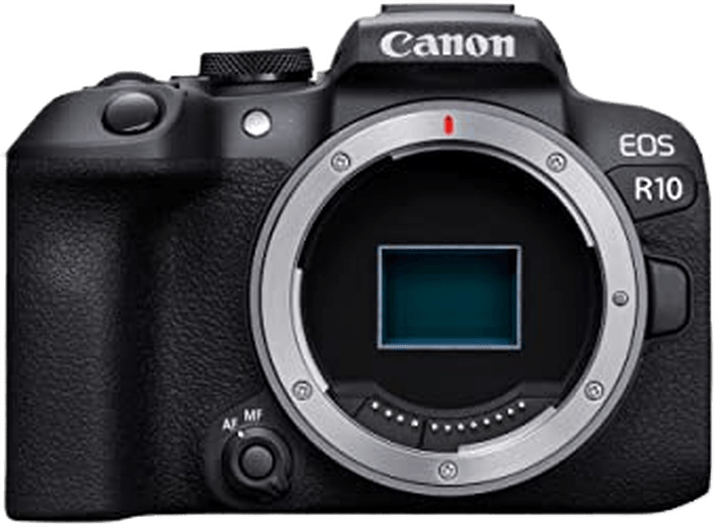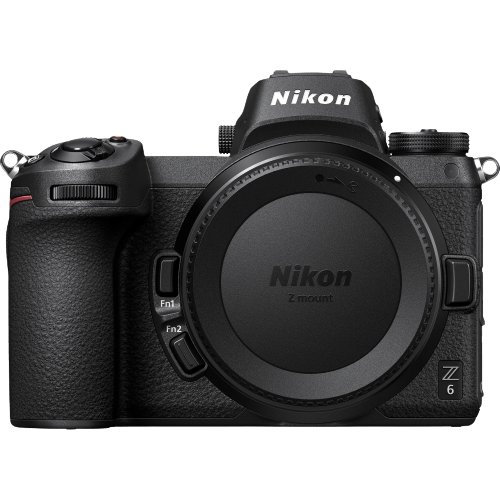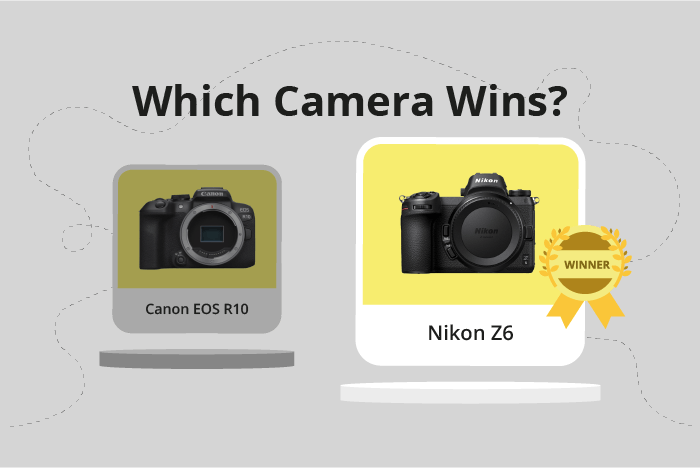Canon EOS R10 vs Nikon Z6 Comparison
Canon EOS R10

Nikon Z6

The Nikon Z6 outperforms the Canon EOS R10 with a score of 81/100 compared to the R10’s 69/100. Both mirrorless cameras share similarities, such as being compact and lightweight, with the R10 measuring 123 x 88 x 83mm and weighing 426g, while the Z6 is slightly larger at 134 x 101 x 68mm and heavier at 675g.
The Canon EOS R10 excels in its lower launch price of $980, making it more affordable than the Nikon Z6, which debuted at $2000. However, the Nikon Z6’s higher score indicates its superiority in other aspects, such as image quality and performance.
Despite the Canon EOS R10’s lower score, it has its advantages, particularly for budget-conscious consumers. On the other hand, the Nikon Z6 offers better overall performance, justifying its higher price tag. Ultimately, the choice between these two cameras depends on the user’s priorities and budget.
Canon EOS R10 vs Nikon Z6 Overview and Optics
The Nikon Z6 outperforms the Canon EOS R10 in optics with a score of 83/100 compared to 71/100. Both cameras share similarities, such as having 24-megapixel CMOS sensors, which provide high-quality images. Additionally, both cameras utilize their respective proprietary lens mounts, the Nikon Z and Canon RF, offering compatibility with a range of lenses from each brand.
The Nikon Z6 surpasses the Canon EOS R10 in several aspects. First, it has a slightly higher megapixel count at 24.5, providing marginally better image resolution. The Z6 also features a full-frame sensor, which captures more light and offers improved low-light performance compared to the R10’s APS-C sensor. Furthermore, the Nikon Z6 has built-in image stabilization, which reduces camera shake and results in sharper images, a feature the Canon EOS R10 lacks.
On the other hand, the Canon EOS R10 has a faster shooting speed of 15 frames per second, compared to the Nikon Z6’s 12 frames per second. This difference allows the R10 to capture fast-moving subjects more effectively. However, its DXOMARK sensor score of 97 falls short of the Z6’s score of 95, indicating a slight advantage in overall image quality for the Nikon Z6.
Considering the differences and similarities, the Nikon Z6 stands out as the superior camera in terms of optics. Its full-frame sensor, higher megapixel count, and image stabilization contribute to its higher score and better performance. While the Canon EOS R10 has a faster shooting speed, it does not compensate for the other advantages the Nikon Z6 offers. Therefore, the Nikon Z6 is the better choice for photographers who prioritize optics quality.
Canon EOS R10 vs Nikon Z6 Video Performance
The Canon EOS R10 outperforms the Nikon Z6 in video capabilities, scoring 91/100 compared to the Nikon Z6’s 83/100. Both cameras share some common specifications, such as 4K maximum video resolution and 3840 x 2160 maximum video dimensions. Additionally, both cameras have built-in time-lapse functionality.
The Canon EOS R10 surpasses the Nikon Z6 due to its higher maximum video frame rate of 120fps, which is double the 60fps offered by the Nikon Z6. This higher frame rate allows the EOS R10 to produce smoother slow-motion footage and capture fast-moving subjects with greater clarity. The increased frame rate contributes to the superior video score of the Canon EOS R10.
On the other hand, the Nikon Z6 does not have any specific advantages in video capabilities over the Canon EOS R10. Both cameras have the same maximum video resolution and dimensions, as well as built-in time-lapse functionality. The only difference lies in the maximum video frame rate, where the Canon EOS R10 holds the upper hand.
Considering the above points, the Canon EOS R10 proves to be the better camera for video capabilities due to its higher maximum video frame rate. The Nikon Z6, while still offering 4K video and time-lapse functionality, falls short in comparison to the EOS R10. This makes the Canon EOS R10 a more suitable choice for videographers and content creators seeking advanced video features and performance.
Canon EOS R10 vs Nikon Z6 Features and Benefits
The Nikon Z6 outperforms the Canon EOS R10 in features, with a score of 87/100 compared to the Canon’s 70/100. Both cameras share several specifications, including a touchscreen, WIFI, Bluetooth, and the lack of GPS. However, the Nikon Z6 offers more advanced features that contribute to its higher score.
The Nikon Z6 has a larger screen size of 3.2 inches, compared to the Canon EOS R10’s 3-inch screen. Additionally, the screen resolution on the Nikon Z6 is significantly higher at 2,100,000 dots, while the Canon EOS R10 has a resolution of 1,040,000 dots. This means that the Nikon Z6 provides a clearer and more detailed display for users.
On the other hand, the Canon EOS R10 has a flip screen, which the Nikon Z6 does not have. This feature can be useful for capturing images at different angles and for vlogging purposes. However, this advantage may not be enough to compensate for the Nikon Z6’s superior screen size and resolution.
In terms of features, the Nikon Z6 is the clear winner with its larger screen size and higher resolution. These advantages make it a better camera for users who prioritize a high-quality display. The Canon EOS R10’s flip screen provides some benefits, but it does not outweigh the Nikon Z6’s overall superiority in features.
Thus, the Nikon Z6 is the better choice for photographers and videographers who prioritize advanced features and a high-quality display. Meanwhile, the Canon EOS R10 may be more suitable for users who specifically require a flip screen for certain shooting scenarios.
Canon EOS R10 vs Nikon Z6 Storage and Battery
The Canon EOS R10 outperforms the Nikon Z6 in storage and battery with a score of 40/100 compared to the Nikon’s 35/100. Both cameras have a single memory card slot and offer USB charging. The Canon EOS R10 accepts SD/SDHC/SDXC (UHS-I compatible) memory cards, while the Nikon Z6 uses XQD memory cards.
The Canon EOS R10 has a significant advantage in battery life, offering 450 shots per charge with its LP-E17 battery. This is a clear benefit over the Nikon Z6, which only provides 310 shots using the EN-EL15b battery. The longer battery life of the Canon EOS R10 ensures extended shooting sessions and less frequent battery changes.
However, the Nikon Z6’s use of XQD memory cards may offer faster read and write speeds compared to the Canon EOS R10’s SD cards. This could be beneficial for photographers who prioritize quick data transfer and processing times.
To sum up, the Canon EOS R10’s superior battery life makes it a better choice for those who require longer shooting sessions. On the other hand, the Nikon Z6 may be more suitable for users who prioritize faster memory card performance.
Canon EOS R10 vs Nikon Z6 – Our Verdict
Are you still undecided about which camera is right for you? Have a look at these popular comparisons that feature the Canon EOS R10 or the Nikon Z6:

